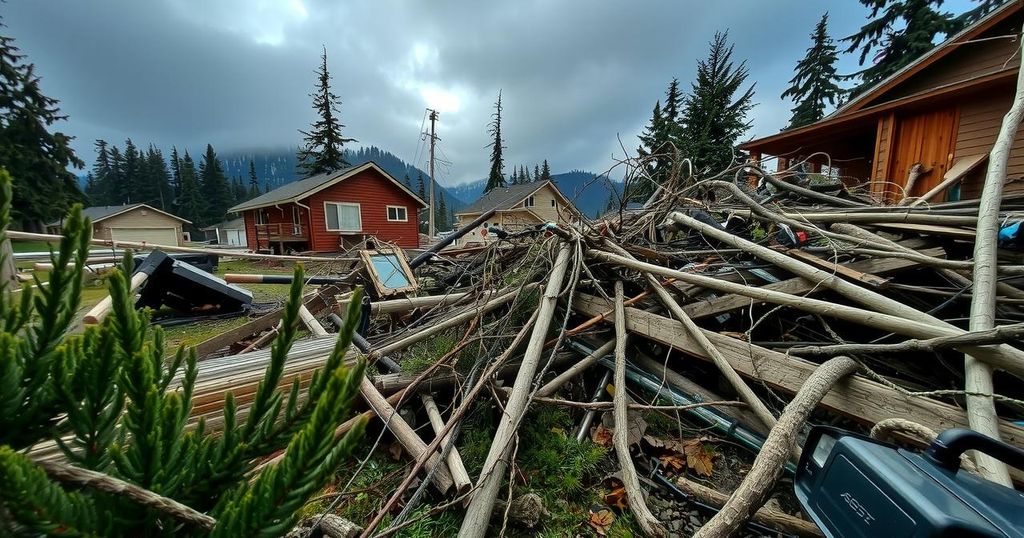Western Washington Faces Challenges in Storm Recovery as New Weather Threatens
Western Washington is recovering from a severe windstorm that caused extensive damage and left over 378,000 customers without power. Schools have closed in several districts, and multiple roads remain blocked. A new storm system is expected to complicate recovery efforts. Food safety and carbon monoxide risks during outages have been highlighted, and local utility companies are actively working to restore power amid ongoing weather threats.
Western Washington is currently dealing with the aftermath of a powerful windstorm that struck the region on Tuesday night, causing extensive damage, downing trees, toppling power lines, and resulting in at least two fatalities. As of late Wednesday, over 378,000 customers in the Puget Sound area were still without power, significantly down from the peak outage numbers. The National Weather Service has indicated that, while the primary storm system is weakening and moving offshore, a new storm system is anticipated to follow closely behind, potentially complicating recovery efforts and leading to additional severe weather hazards by Friday.
In the wake of the storm, several school districts in the Seattle area announced closures to facilitate recovery efforts. Districts including Issaquah, Renton, and Bellevue have opted to keep schools closed due to ongoing cleanup operations and power outages resulting from the severe weather. Other districts have varying operational statuses, with some maintaining normal schedules for schools that still have power.
Road closures continue to pose challenges with numerous routes blocked by fallen trees and debris. King County has reported several specific road closures in the region, which are crucial for both residents and emergency services. Additionally, state highways affected by the high winds are being monitored for safety, with some undergoing avalanche control measures.
Food safety guidelines during power outages have also been highlighted due to the large number of customers still without electricity. The USDA recommends that perishable items should be discarded if they have been exposed to temperatures above 40 degrees Fahrenheit for extended periods. Furthermore, carbon monoxide poisoning remains a concern as many resort to generators during outages—emphasizing the importance of proper ventilation and safety practices.
As recovery efforts continue, power restoration crews are actively working to restore electricity to affected areas, with an estimated 325,000 customers still experiencing outages as of Thursday morning. Puget Sound Energy announced that assistance crews from neighboring states are aiding in the restoration process, highlighting a collaborative effort in the face of the challenges posed by the storm. Weather forecasts indicate the likelihood of additional severe weather, raising concerns about its impact on restoration efforts and the potential for further damage.
Local authorities and utility companies are advising residents to stay informed about safety procedures during this tumultuous time and to report any dangers encountered due to lingering storm effects. Community involvement is encouraged, with local news outlets inviting residents to share their experiences and evidence of the storm’s impact.
The real-time situation in Western Washington remains fluid, with authorities urging vigilance as they navigate the challenges presented by a series of impactful storm systems. The recovery from this windstorm underscores the resilience of the community and the significance of preparedness as they face immediate weather threats in the days to come.
The recent windstorm hitting Western Washington was categorized as a bomb cyclone, a meteorological phenomenon characterized by rapid drops in atmospheric pressure that can lead to severe weather conditions. This particular storm has had significant impacts on the infrastructure, community safety, and day-to-day operations in the region. The residual effects of such a storm include power outages, school closures, and widespread damage, necessitating a coordinated recovery effort among utility companies and local governments. The arrival of subsequent storm systems raises concerns for further disruptions and complicates recovery efforts.
In summary, Western Washington is facing significant recovery challenges following a devastating windstorm caused by a bomb cyclone. With hundreds of thousands without power and numerous schools closed, the community is working diligently to restore normalcy. Ongoing weather threats heighten the urgency of these recovery efforts, emphasizing the need for resident safety measures and effective public utility communication. As the situation evolves, the region’s resilience remains steadfast in the face of natural adversity.
Original Source: www.seattletimes.com




Post Comment